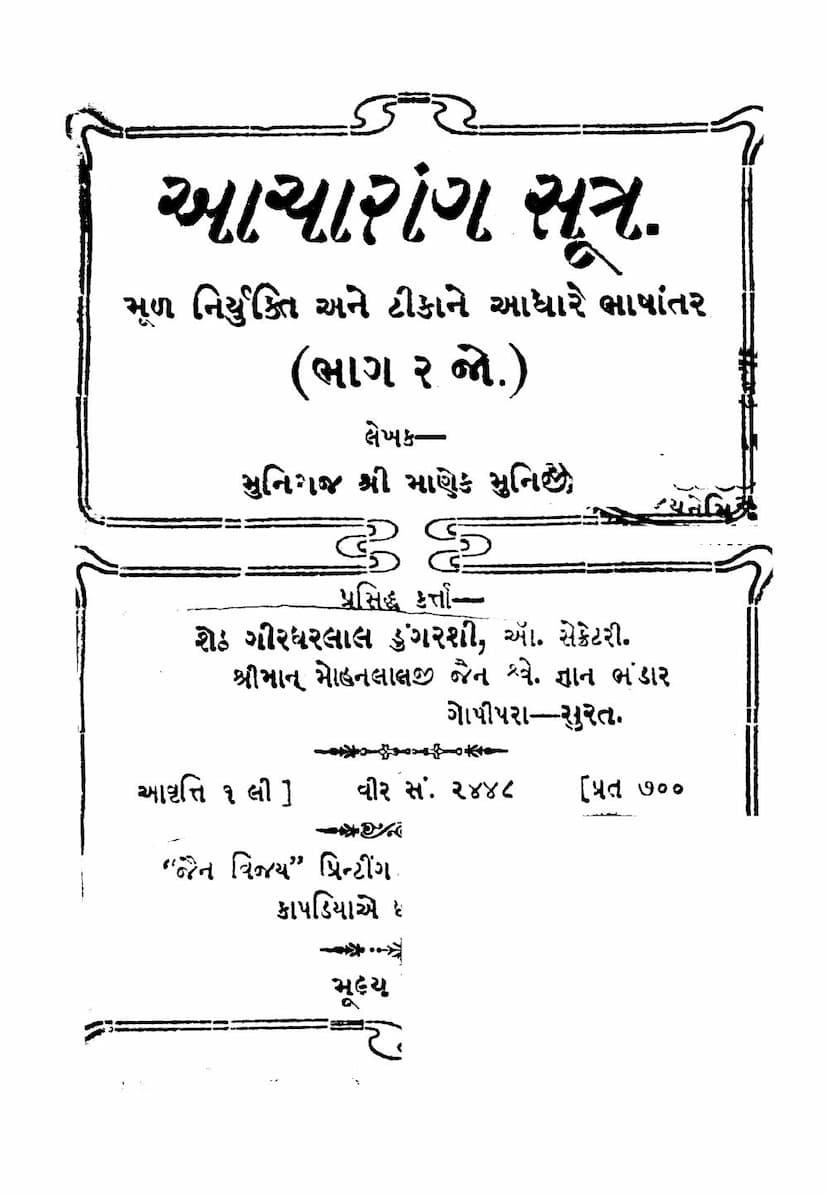Acharanga Sutra Part 02
Added to library: September 2, 2025

Summary
This document is the second part of the Acharanga Sutra, translated based on the Moola Nirukti and commentary by Muni Shri Manek Muni. Published by Mohanlal Jain Shwetambar Gyan Bhandar, it is priced at 700 rupees and is in its first edition, released in Veer Samvat 2448.
Preface: The first part of the Acharanga Sutra contained the first study, Shastra Parigya, along with its commentary translation. This second part focuses on the study named Lokavijaya (Victory over the World). This study has six udeshas (sections), the contents of which are detailed by the Niruktikar (commentator on the Niruktis). The primary focus of Lokavijaya is the world, understood as the cycle of births and deaths driven by karma. The text aims to guide monks to avoid actions that lead to the binding of inauspicious karma and subsequent transmigration through different life forms. The commentator highlights the depth of the commentary and the spiritual peace derived from reading it, encouraging readers to refer to the explanations provided.
Subject Index: The index provides a breakdown of the topics covered in the second study, Lokavijaya, and its relationship to the first study, Shastra Parigya.
- The first study established the existence of the soul and how it binds karma through inauspicious actions related to harming life.
- The second study, Lokavijaya, details how a monk should avoid such bindings and escape them. It covers four anugadwars (modes of inquiry) and the themes within its six udeshas, as outlined by the Niruktikar in 163 gathas (verses).
Themes of the Six Udeshas:
- Renunciation of Familial Affection: A monk should detach from worldly relatives after taking initiation.
- Steadfastness in Restraint: A monk should not be lax in observing samyama (restraint) but should be detached from worldly pleasures and passions.
- Rejection of Pride: Pride is not beneficial. A monk should thoughtfully abandon all forms of pride related to lineage, status, etc.
- Detachment from Pleasures: Avoiding attachment to sensual pleasures, especially those involving women, as they lead to suffering.
- Dependence on Lay Supporters: A liberated monk, while maintaining detachment, should depend on householders for sustenance to continue their spiritual path.
- Non-Attachment to Supporters: Even when receiving support from householders, a monk should remain detached, like a lotus that grows in mud but remains unstained.
The index also lists specific sections related to the nikshepa (classification) of Lokavijaya, kashayas (passions), samsara (cycle of existence), and karma, including verses from the Nirukti and details on the preciousness of time and the release from worldly suffering.
Correction Slip (Shuddhipatra): This section lists corrections for errors found in the text.
Acknowledgments and Financials: The text also includes acknowledgments to individuals and groups who supported the publication, detailing financial contributions and expenses related to printing and distribution. It highlights a plan to publish future parts and distribute books to religious institutions.
Overall Purpose: The Acharanga Sutra, particularly this second part focusing on Lokavijaya, is a foundational text in Jainism that guides ascetics on the path to liberation. It delves into the nature of the soul, the mechanisms of karma, and the ethical and spiritual practices necessary to break free from the cycle of rebirth. The commentary and the detailed index aim to make these profound teachings accessible and understandable to a wider audience.